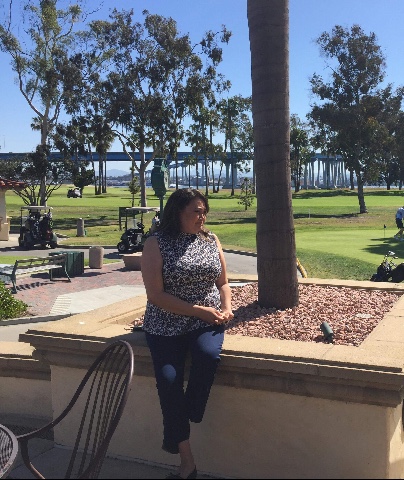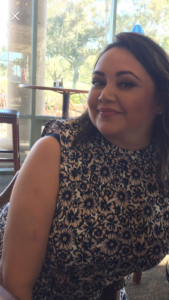When you traverse the San Diego Coronado Bridge, or even see it in pictures, one thing that is undeniable, is that it’s majestic and tall, 246-feet tall. What outsiders don’t always know, but locals know all too well, is that it is also riddled with tragedy.
 As I sit across from Bertha Loaiza and listen to her story, I can’t help but know that this woman is alive today to share her unbelievable and courageous story. Bertha was born to a young married couple who had made their life in San Diego, she was their only child. On August 5, 1985, when Bertha was just a month shy of her 4th birthday, tragedy struck. Bertha’s mother, 24-year-old Angelica Medina who had been medically discharged from the Army with depression and bipolar disease, made an irreversible decision. She drove her Pinto to the top, midspan of the bridge, got out, took her daughter in her arms and went over the edge. Taking her life along with her small child. They were pulled from the water by two nearby fishermen after being submerged for minutes. Life-saving efforts were given to the two; sadly, Bertha’s mother was unable to be saved. It is believed that Angelica’s body hit the water first softening the landing for her daughter who sustained a multitude of injuries to her right side including a collapsed lung, crushed knee and hip, brain swelling and traumatic cataract to her right eye. The miracle was that she lived. She is the first person to have gone over the bridge and survived.
As I sit across from Bertha Loaiza and listen to her story, I can’t help but know that this woman is alive today to share her unbelievable and courageous story. Bertha was born to a young married couple who had made their life in San Diego, she was their only child. On August 5, 1985, when Bertha was just a month shy of her 4th birthday, tragedy struck. Bertha’s mother, 24-year-old Angelica Medina who had been medically discharged from the Army with depression and bipolar disease, made an irreversible decision. She drove her Pinto to the top, midspan of the bridge, got out, took her daughter in her arms and went over the edge. Taking her life along with her small child. They were pulled from the water by two nearby fishermen after being submerged for minutes. Life-saving efforts were given to the two; sadly, Bertha’s mother was unable to be saved. It is believed that Angelica’s body hit the water first softening the landing for her daughter who sustained a multitude of injuries to her right side including a collapsed lung, crushed knee and hip, brain swelling and traumatic cataract to her right eye. The miracle was that she lived. She is the first person to have gone over the bridge and survived.
Following her mother’s death, she was raised by her maternal grandparents in the South Bay area. As she grew, her family shared that her mother had been lost in an accident. She imagined a car accident and as she recounted the story to friends and acquaintances, she added that it had something to do with drunk driving. It wasn’t until she was 17 years old that she accidentally came across an unlabeled VHS tape of the news reports. She was completely unprepared for what she was about to learn when she popped the tape into the VCR. The accident was not a vehicle, it was a suicide. She learned that her mother had not only decided to take her own life but to take Bertha’s as well. In addition to her mother’s depression, her parents had been in the midst of a divorce. It seems she saw no other way out at 24 years old.
Bertha has spent decades in therapy and support groups.  Many of the years she too suffered from depression and would go into hiding when someone would discover she was “that girl,” as she struggled to make sense of it as a mother to her own children, now 10-year-old son and 6-year-old daughter. She shares one of the toughest years was when her son, her first child, turned three. She spent the year paranoid for his safety and looking at him daily asking herself, “why would she do this?” Albeit Bertha has no memory of the incidents on that day as often happens when people suffer traumatic stress; but she knows it changed the trajectory of her life. She has now explained to her children that her mother was ill. She told them she had a mental illness which is like having a “brain attack.”
Many of the years she too suffered from depression and would go into hiding when someone would discover she was “that girl,” as she struggled to make sense of it as a mother to her own children, now 10-year-old son and 6-year-old daughter. She shares one of the toughest years was when her son, her first child, turned three. She spent the year paranoid for his safety and looking at him daily asking herself, “why would she do this?” Albeit Bertha has no memory of the incidents on that day as often happens when people suffer traumatic stress; but she knows it changed the trajectory of her life. She has now explained to her children that her mother was ill. She told them she had a mental illness which is like having a “brain attack.”
This courageous woman has decided to share her story in hopes that it will have an impact on the need for suicide barriers on the bridge. She told me she is not ashamed and is adamant that if one life is saved because she has shared her story it will be worth it. She also said she never wants me or any other reporter to have to cover a suicide or suicide survivor story. Bertha is truly a woman of grace and a dash of sass. She has the ability to make people laugh in the face of adversity. A gift she shares now with the world.
 Bertha was accompanied by Bonnie Bear, with SOSL (Survivors of Suicide Loss), whose husband, a psycho-therapist, took his life in August 2002 one day before their 37th wedding anniversary. His suicide was brought on by depression that physicians were unable to control. Michele Madden lost her brother Jamie in 2004 to suicide. Michele is a participant and facilitator who now works for SOSL to help others. Regarding her brother, she shared that there were no warning signs, and she has chosen this career path so his death was not in vain. Kayce Jones, mother and wife, also joined them. Kayce’s life was spared when someone stopped on the bridge as she contemplated the leap.
Bertha was accompanied by Bonnie Bear, with SOSL (Survivors of Suicide Loss), whose husband, a psycho-therapist, took his life in August 2002 one day before their 37th wedding anniversary. His suicide was brought on by depression that physicians were unable to control. Michele Madden lost her brother Jamie in 2004 to suicide. Michele is a participant and facilitator who now works for SOSL to help others. Regarding her brother, she shared that there were no warning signs, and she has chosen this career path so his death was not in vain. Kayce Jones, mother and wife, also joined them. Kayce’s life was spared when someone stopped on the bridge as she contemplated the leap.
All of these women are showing up to support one another and others who have lost loved ones through suicide, or who are dealing with mental illness. Loaiza is now associated with the Coronado San Diego Collaborative for Suicide Prevention in an effort that her story may save lives and assist in the installation of barriers on the bridge. I was told by a member of the San Diego Harbor Patrol and a member of the Coronado Fire Department that there are months when four and five bodies are plucked from the bay, sadly having succeeded in ending their lives from the bridge.
If you or someone you know is suffering from depression, do not delay in seeking help. There are people who care, who have been there and will listen, guide and support you.
Suicide Prevention Hotline 888-724-7240
Survivors of Suicide Loss 619-482-0297




